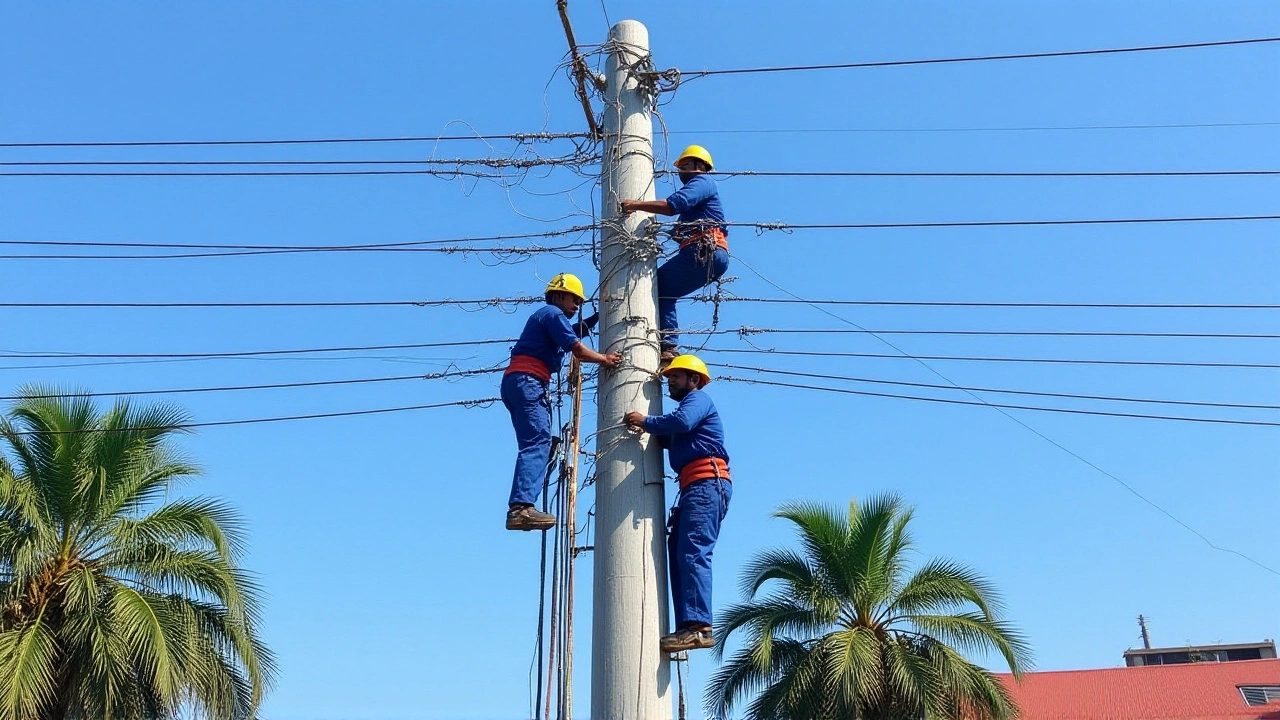When Kenya Power & Lighting Company Plc (KPLC) announced a fresh tender for 2,555 pole‑mounted distribution transformers, the utility signaled a serious push to keep the grid humming as new connections soar. The invitation, released on June 27, 2025, asks eligible local manufacturers to submit bids by . John Mutua, a Business Daily Africa reporter, first broke the story, noting that the move follows an April procurement worth Sh3.9 billion.
Background: Why Kenya Needs More Transformers
Electricity demand in Kenya has been climbing at roughly 10 % per year, driven by rapid urbanisation, expanding industry, and a surge in illegal connections that overload the network. Alex Vashira, Energy Principal Secretary, warned that “illegal connections are a major cause of transformer failures, especially in regions we prefer not to name.” The resulting damage leaves households and businesses in darkness, prompting KPLC to build a buffer of critical equipment.
Details of the New 2,555‑Transformer Tender
The current tender targets pole‑mounted units ranging from 25 kVA to 100 kVA. These devices step down high‑voltage power to levels safe for homes and commercial premises. KPLC’s own statement reads: “The Kenya Power & Lighting Company Plc invites bids from eligible tenderers for the supply of pole‑mounted distribution transformers (local manufacturers).” No monetary value was disclosed, but the scale suggests a multi‑million‑shilling contract.
Local firms have until the July 4 deadline to lodge their proposals, after which KPLC will evaluate them based on technical compliance, price, and delivery schedule. The utility hopes to complete the award within two weeks, mirroring the swift pace of its April procurement.
Earlier April Procurement and Its Impact
Back in April 2025, KPLC launched a Sh3.9 billion tender for 3,319 distribution transformers, overseen by John Ngeno, General Manager for Supply Chain and Logistics. That deal allocated more than 85 % of the units to customers who had already paid for new connections, with the remaining stock earmarked to replace stolen or vandalised transformers across the country.
The April order comprised 1,079 units of 50 kVA 11/0.42 kV and 840 units of 50 kVA 33/0.42 kV, among others. KPLC aimed to ship the equipment within 14 days—a target it met after earlier delays caused by budget cuts from the National Treasury. The rapid turnaround helped reconnect thousands of paying customers and reduced the number of outages linked to transformer theft.
Government Support and the Broader Infrastructure Push
In June 2025, the Kenyan government pledged Sh4.3 billion (approximately $33.2 million) to replace over 20,000 defective transformers nationwide. This funding underpins a larger 4.3 billion‑shilling initiative to modernise the grid, reinforce distribution lines, and curb commercial losses from inefficiencies.
Beyond KPLC’s own network, the transformed stock will support entities such as the Rural Electrification and Renewable Energy Corporation (REREC), which battles transformer shortages that impede rural power connections. By sourcing locally, the tender also aims to boost Kenya’s manufacturing sector, creating jobs and reducing reliance on imports.
Challenges Ahead and What Lies Next
Despite the aggressive procurement schedule, KPLC still faces hurdles. Budget constraints linger, and the persistence of illegal connections threatens to sap the lifespan of newly installed units. Moreover, supply‑chain bottlenecks for raw steel and copper could delay production, especially if global commodity prices stay high.
Looking forward, KPLC plans to monitor the performance of the newly installed transformers closely, using smart‑meter data to flag overloads early. The utility also intends to launch an awareness campaign targeting illegal connections, coupling enforcement with community outreach.
- Key Fact 1: 2,555 transformers requested, capacity 25‑100 kVA.
- Key Fact 2: Bids due by July 4, 2025.
- Key Fact 3: Earlier April tender secured 3,319 transformers for Sh3.9 billion.
- Key Fact 4: Government earmarked Sh4.3 billion to replace 20,000+ faulty units.
- Key Fact 5: Electricity demand growing ~10 % annually.

Frequently Asked Questions
Why is Kenya Power focusing on pole‑mounted transformers now?
Pole‑mounted units are quicker to install and cheaper than pad‑mounted alternatives, making them ideal for rapidly expanding suburban areas where KPLC is seeing the highest surge in new connections.
How does the July 4 deadline affect local manufacturers?
The tight timeline pushes firms to showcase their production capacity and financial stability early, potentially rewarding those with already‑stocked inventory or efficient supply chains.
What role does the government’s Sh4.3 billion allocation play?
The funding backs a nationwide replacement programme, targeting over 20,000 defective transformers. It complements KPLC’s tender by ensuring there’s enough capital to cover the cost of both new and replacement units.
Will this procurement create jobs in Kenya?
Yes. By sourcing from local manufacturers, the tender is expected to generate hundreds of direct manufacturing jobs and ancillary work for logistics, installation, and maintenance crews.
How does illegal wiring affect transformer lifespan?
Illegal connections overload transformers, causing excessive heat and premature failure. This not only leads to costly replacements but also sporadic outages for legitimate customers.








Janette Cybulski
October 3, 2025 AT 05:57It's encouraging to see KPLC pushing for more locally‑made transformers – that kind of investment can really lift both the grid and the manufacturing sector. When firms get these contracts they’ll need to hire more skilled workers, which means jobs for engineers and welders in the area. Plus, shorter lead times from nearby factories should help keep the rollout on schedule, especially with demand climbing 10 % each year. Hopefully the new units will also be more resilient against the illegal hookups that keep causing outages. In the long run this could make power more reliable for households and small businesses alike.
Mildred Alonzo
October 4, 2025 AT 23:37The tender deadline is tight but manageable it forces firms to prove they can deliver quickly. Local manufacturers who already have inventory will have a clear edge.
Elizabeth Bennett
October 6, 2025 AT 17:17KPLC’s approach of bundling new connections with transformer upgrades makes a lot of sense economically. By tying the supply to paying customers it reduces the risk of non‑payment and ensures the equipment is actually needed. The government’s Sh4.3 billion allocation adds a safety net for replacing the older faulty units, which should curb the frequent blackouts we’ve seen in some regions. Still, the persistent problem of illegal connections will continue to stress the new hardware unless enforcement improves. On the production side, local firms will likely benefit from the scale of this order, gaining experience that can be exported to neighboring countries. Overall, it’s a step forward, but sustained policy focus will be required to protect the investment.
linda menuhin
October 8, 2025 AT 10:57When you look at a transformer you’re really staring at a tiny guardian of light, a silent hero that turns chaos into comfort. It's funny how we take that for granted until the night swallows our homes because someone...screwed up the wiring. The grid is a living thing, pulsing with electrons that need proper channels, not the wild vines of illegal hacks. If we keep ignoring the root cause – the greed and desperation that drive people to pirate power – we'll just keep rebuilding broken bones. So maybe the answer lies not just in more metal, but in educating the neighborhoods about why stealing electricity hurts everyone. The new pole‑mounted units are like sturdy pillars, but even pillars crumble if the foundation is rotten. Let’s hope KPLC pairs the hardware push with real community outreach, otherwise we're just putting a band‑aid on a broken leg. In the end, progress is a blend of tech and trust, and both have to grow together.
Jeff Abbott
October 10, 2025 AT 04:37Sure, more transformers will fix the grid – if only the thieves would stop treating the wires like a free buffet.
Quinton Merrill
October 11, 2025 AT 22:17Totally agree 😊 Local jobs are a big win and faster delivery means fewer outages. The demand spike really does need that extra capacity, and the government cash helps keep prices in check. Let’s hope the contracts are awarded transparently so the right firms get the boost.
Linda Lawton
October 13, 2025 AT 15:57I can't help but wonder if the push for so many new transformers is a cover for something bigger. The timing lines up with a wave of foreign investors suddenly interested in Kenya’s steel and copper markets, and that can’t be a coincidence. Some insiders say the tender specs were tweaked at the last minute to favor companies that already have contracts with overseas suppliers. If those firms get the bulk of the order, they’ll control a huge chunk of the country’s energy infrastructure. That kind of leverage could be used to negotiate favorable trade deals, or even to pressure the government on policy matters. Meanwhile, the real victims are the small local manufacturers who never stand a chance against the hidden giants. The narrative about job creation is nice, but the numbers don’t add up when you look at the actual employment figures from previous tenders. And let’s not forget the illegal connections – they’re not just a technical problem, they’re a symptom of people feeling excluded from the benefits of development. When the power keeps getting taken over by a few big players, the rest of us are left scrambling for scraps. I’ve heard that some of the proposed transformers are actually over‑speced for the regions they’ll serve, a classic way to inflate costs. The government’s Sh4.3 billion fund could be funneled through shell companies, making it hard to trace the real beneficiaries. All this while the average Kenyan still faces daily outages and high electricity bills. It feels like a classic case of a “new infrastructure” agenda that masks an underlying agenda of resource control. Transparency is the only way to keep this from turning into another scandal. We need independent audits, public disclosures, and real community involvement if this is ever going to be more than a smoke‑screen.
Ashley Bradley
October 15, 2025 AT 09:37Contemplating the surge of transformer procurement invites us to reflect on the broader rhythm of modern development. Each pole‑mounted unit is a small node in a vast network that mirrors how societies interconnect, sharing both power and responsibility. When KPLC invests heavily in these components, it signals a belief that infrastructure can be the backbone of progress, yet it also reveals the fragility of that backbone when strained by illegal practices. The very act of securing contracts from local manufacturers is a statement about economic sovereignty, an attempt to keep the wealth generated within national borders. However, sovereignty is only meaningful when accompanied by accountability, lest the process become a mere veneer for patronage. The rapid turnaround time praised in the April procurement hints at bureaucratic efficiency, but also raises questions about due diligence and quality assurance. A rapid award may reduce downtime for customers, but if the equipment fails prematurely, the cost-both financial and social-can be far greater. Moreover, the interplay between public funding and private enterprise must be navigated carefully to avoid the pitfalls of rent‑seeking behavior. While the government’s earmarked Sh4.3 billion underscores a commitment to the grid, the allocation mechanism must be transparent to maintain public trust. The recurring problem of illegal connections suggests a deeper socio‑economic issue: a gap between the cost of formal electricity and the lived realities of many households. Addressing this gap requires more than technical fixes; it demands inclusive policies that make electricity affordable and reliable. In that sense, the transformer tender is only one piece of a larger puzzle that includes education, enforcement, and community engagement. If the utility can harness smart‑meter data to pre‑empt overloads, it will have a powerful tool for proactive maintenance, yet the data must be used ethically and with respect for privacy. Ultimately, the success of this initiative will be measured not just by the number of transformers installed, but by the reduction in outages, the increase in legitimate connections, and the empowerment of local industries. Such outcomes would truly validate the vision of a resilient, self‑sufficient energy ecosystem.
Joe Delaney
October 17, 2025 AT 03:17Nice summary of the benefits and challenges KPLC faces its good to see the balanced view
Ruben Vilas Boas
October 18, 2025 AT 20:57The deadline may be tight but it pushes everyone to step up and deliver quality work. Keeping the process clear will help local firms succeed.